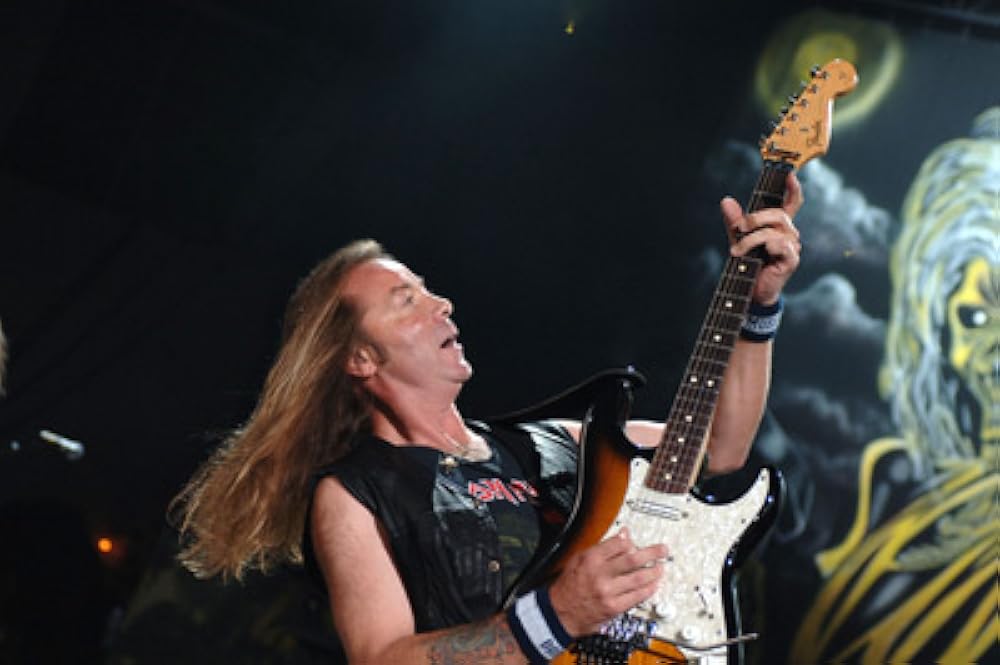
As Iron Maiden guitar legend Adrian Smith recalls, coming up with lead guitar parts with his axe-wielding partner in crime, Dave Murray, came naturally and without too much discussion.
Smith joined Iron Maiden in 1980, not long after the release of the band’s self-titled debut record and the firing of Dennis Stratton. Although different from Stratton’s more classic-rock-oriented approach, you could notice Smith’s obvious blues influences in his lead parts. Three incredible albums lined up — “Killers,” “The Number of the Beast,” and “Piece of Mind” — and it was time for yet another superb record.

In his recent interview with Guitar World, Adrian reflected on the creative process behind the music that would end up on 1984’s “Powerslave” record. The album is full of Smith’s and Murray’s lead parts and, as Smith explained, they came on top of a finished song but were conceived to serve the piece.
“As far as our intent, it was still about the song,” the guitarist said. “We’d just write the song, and then Dave and I would worry about the solos after.”
Going more into the matter, Adrian also said that he and Murray easily communicated through music. We all know how perfectly their solos flow from one to another and this came pretty much intuitively to them.
“Dave and I rarely spoke about it,” he said. On top of that, Smith had a few songs credited to him on the album, including “2 Minutes to Midnight,” one of Iron Maiden’s biggest songs that he co-wrote with Bruce Dickinson.
YouTube preview picture
As he explained, and as we can also notice ourselves, there was a clear distinction between his writing and that of the band’s founder and bassist Steve Harris:
“I’d started writing more, but Steve wrote many of the harmonies. Steve wrote the harmony sections on ‘Aces High,’ which was typical. When I’d write, I never had harmony guitars; I arrived at things differently.”
Going back to the solos, Adrian also added that writing these parts “came down to Dave and I knowing each other rather than talking.”
“Powerslave” also marked the band’s fourth record with producer Martin Birch. This was about the halfway through as Martin would go on to produce four more studio albums for Maiden before retiring. Knowing Martin’s reputation and impressive albums he worked on until that point, he was an authoritative figure in the metal business. Smith said of him:
“Martin worked with all the giants. When he suggested something, you took notice.”
“Considering all he’d done, it was a matter of trying to impress him and wanting to do a good job. You were probably doing pretty well if he thought highly of you.”
I recall when I was in my early ’20’s when my friends and I were metal fans, but not very familiar with the NWOBHM acronym. Back then Iron Maiden and Judas Priest, Priest first, due to seniority, and Black Sabbath were as heavy as we figured it could get until Motorhead and others came along in a fury. Saxon was one we figured would be huge, and in the UK/Europe they were, as far as I knew. Raven took a little startup band called Metallica on that band’s (Metallica’s) first US club tour, one I’ve mentioned many times I got to see about five feet from Hetfield and Hammett. Burton was denim, and just looked like the last person any supposed tough guy would dare to tangle with.
Maiden was tougher somewhat with a slightly more tarnished approach and punk overtones that helped in Europe meld their punk rock and metal of the day. In the US they helped develop our crossover/thrash and then Bay Area/ NYC thrash. And metal historians sometimes overlook the metal world in New York City and places nearby.
NYC in particular was intergral in ass kicking metal as SF, Tampa or anywhere in Britain. They had probably the planet’s most unique variety of music, but the first bunch included Blue Oyster Cult, KISS, Riot, but was full of punk as well. Then, one of the great thrash bands from there is/was Overkill. They’ve been around a long time and never disappoint, with a super heavy line-up, great albums that just get heavier all the time, like Horrorscope, I Hear Black, Killbox 13, Ironbound, The Electric Age and the new one Scorched.
Prong is equally heavy with some punk elements from the early years and one of NYC’s best. I’ll wrap up since these are mainly older bands for younger fans to check out, and I am just as clueless as a turtle on lots of band origins since they are so prevalent and scattered.
I want to tip the metal derby to Anthrax, the only band to be in the Big 4 from the East Coast, and Whiplash, another ultra heavy thrash outfit from the same. Their second album to me is nearly death metal before they decided to turn toward a slightly more melodic style. However, if you can find it, Ticket To Mayhem is a brutal slab, and calling it death metal is not an insult. It is tougher and femur breaking than anything Megadeth ever did.
Leave a Reply